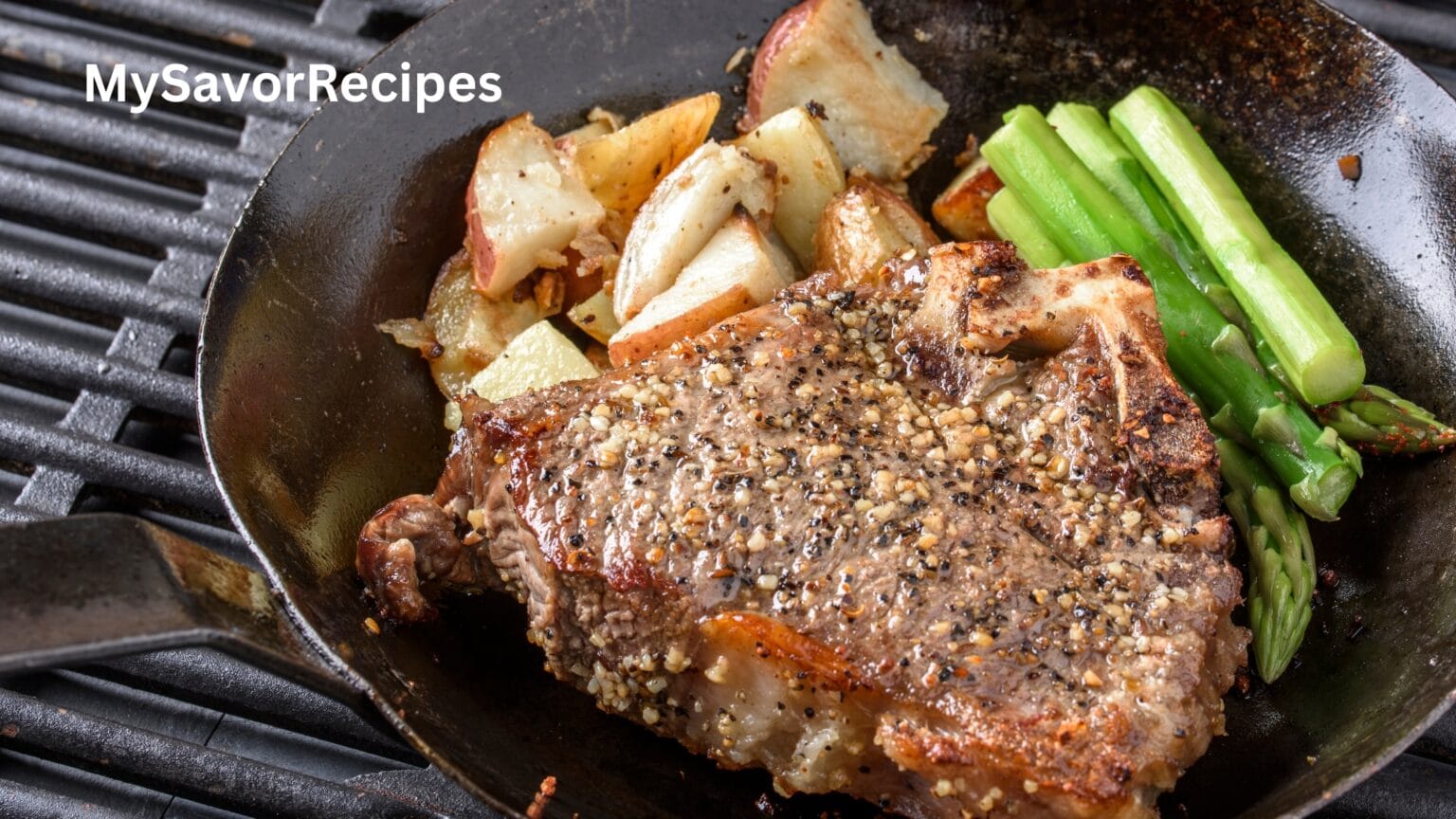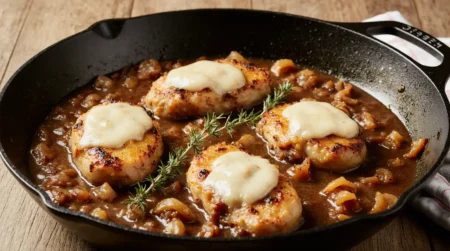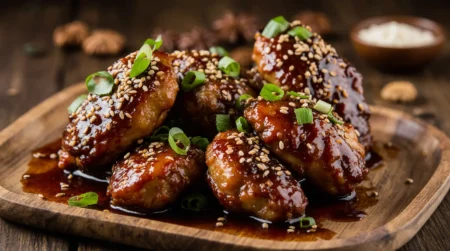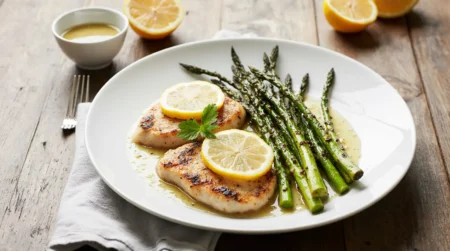Pan-Seared Steak in Butter Sauce
The sizzle of a perfectly pan-seared steak can turn an ordinary evening into a feast. Every home cook wants to make that perfect homemade steak recipe. It’s the one that makes taste buds dance and impresses guests.
Imagine cutting into a steak with a golden-brown crust. Inside, it’s tender and juicy, melting in your mouth. This isn’t just cooking – it’s an art form. It combines precision, technique, and passion.
Whether you’re new to cooking or have years of experience, this guide will help. You’ll learn how to make a steak that’s as good as any high-end steakhouse.
Table of Contents
Key Takeaways
- Learn professional techniques for pan-searing steak
- Discover the perfect butter sauce method
- Understand how to select the right cut of meat
- Master temperature control for ideal doneness
- Create restaurant-quality meals at home
Understanding the Perfect Pan-Seared Steak
Mastering the art of pan-searing a steak is a mix of skill and knowledge. Using butter in your cooking can turn a simple steak into a dish fit for a restaurant. It will surely impress anyone who tries it.
Types of Steak Cuts for Pan-Searing
Not all steaks are the same when it comes to pan-searing. Some cuts stand out for their flavor and texture. Here are the best cuts for your pan-seared steak:
- Ribeye: Rich marbling and intense flavor
- New York Strip: Balanced meat-to-fat ratio
- Filet Mignon: Tender and lean
- Sirloin: Leaner option with robust taste
The Science Behind a Great Sear
The Maillard reaction is key to a perfect steak. It happens when meat meets high heat, creating a golden crust. This crust locks in amazing flavors.
| Searing Factor | Impact on Steak |
|---|---|
| High Heat | Creates crispy exterior |
| Dry Surface | Promotes better browning |
| Minimal Movement | Develops deeper crust |
Why Butter Makes Everything Better
Butter does more than add flavor to your steak. It gives it a luxurious, velvety texture. The milk solids in butter caramelize, adding depth and richness.
Pro tip: Use clarified butter or ghee for higher heat cooking to prevent burning while maintaining that rich, buttery flavor.
Essential Equipment for Steak Pan-Searing
Mastering the seared steak method is not just about cooking skills. The right tools can make a big difference. They help create that perfect golden-brown crust when cooking steak in a skillet.
Your essential toolkit for pan-searing steak should include:
- Cast Iron Skillet: The gold standard for heat distribution and retention
- Heavy-bottomed stainless steel pan as an alternative
- Reliable meat thermometer
- Long-handled tongs
- Sharp chef’s knife
- Splatter screen
“The right pan is like a painter’s brush – it can make or break your culinary masterpiece.”
When picking your skillet, look for thick, heavy materials that can handle high heat. Cast iron is the best choice for serious home chefs. It keeps the heat steady, giving you a perfect crust every time.
Other accessories can make cooking better. A digital meat thermometer ensures you get the steak just right. Long tongs help avoid splatters and give you better control.
Pro tip: Spend money on good equipment. Cheap tools can ruin the texture and taste of your steak when pan-searing.
Selecting the Right Cut of Meat for Pan-Searing
Choosing the perfect cut of meat is key to a great Pan-Seared Steak in Butter Sauce. The right choice affects the flavor, texture, and success of your dish.
Not all steaks are the same. Knowing about beef selection can make your cooking better.
Marble Score and Quality Grades
The marble score shows how much fat is in your steak. A higher score means:
- Better flavor
- Softer texture
- A richer taste
USDA quality grades help find top-notch beef:
- Prime: The best, lots of marbling
- Choice: High quality, some marbling
- Select: Leaner, less flavor
Thickness and Size Considerations
Steak thickness is important for Pan-Seared Steak in Butter Sauce. Aim for 1-1.5 inches for the best sear.
Fresh vs. Aged Beef
Beef aging makes it taste better and tender. There are two aging ways:
- Wet aging: Stored in a vacuum
- Dry aging: Exposed to air
Dry-aged steaks have stronger flavors, great for your dish.
Preparing Your Steak for the Perfect Sear
Starting an easy steak dinner begins with the right prep. Your homemade steak recipe will stand out if you follow the right steps before cooking. The goal is to turn a simple piece of meat into a top-notch meal in your kitchen.
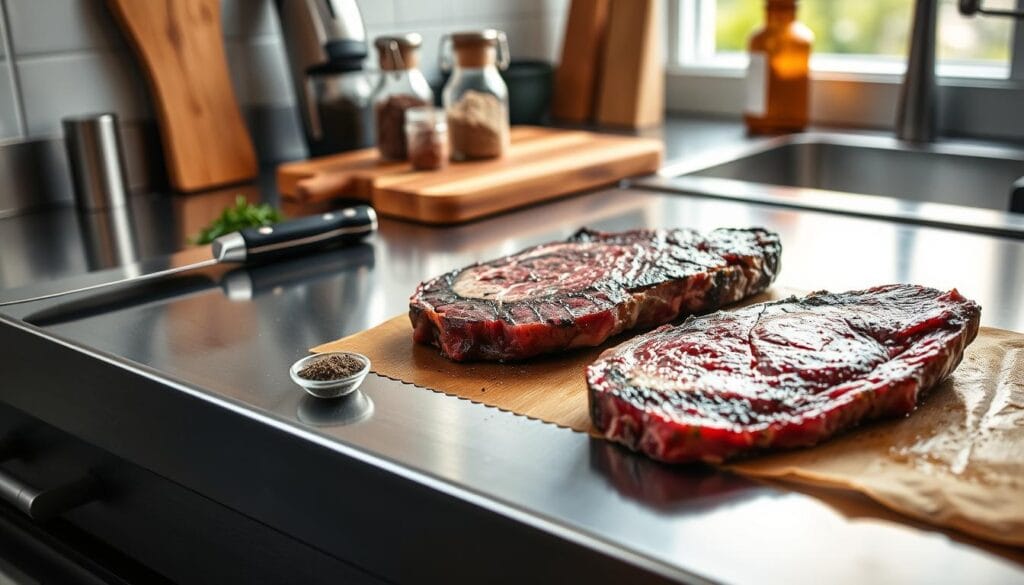
First, take your steak out of the fridge 30-45 minutes before cooking. This step ensures the meat cooks evenly. Then, dry the steak with paper towels – a dry steak is key for a great sear.
- Remove steak from refrigerator 30-45 minutes before cooking
- Pat meat completely dry with paper towels
- Use minimal seasoning for best results
Seasoning is crucial for your steak. Chefs suggest using kosher salt and black pepper generously. The salt helps create a tasty crust and boosts the meat’s flavor.
| Preparation Step | Purpose | Recommended Time |
|---|---|---|
| Room Temperature Rest | Even Cooking | 30-45 Minutes |
| Pat Dry | Achieve Better Sear | Before Seasoning |
| Season | Enhance Flavor | Just Before Cooking |
For a simple steak dinner, oil the steak, not the pan. Use oils like avocado or grapeseed. Brush a thin, even layer on the meat to help it sear beautifully.
Pan-Seared Steak in Butter Sauce: Step-by-Step Method
Mastering the seared steak method needs precision and a bit of art. A perfect Pan-Seared Steak in Butter Sauce turns a simple meal into a fancy dish. It will wow even the pickiest eaters.
Starting with a perfect steak means knowing the key steps. These steps will make your cooking go from good to great. Let’s explore the essential techniques for a delicious steak.
Temperature Control Techniques
Getting the right temperature is key for a perfect sear. Here are some important tips:
- Take the steak out of the fridge 30-45 minutes before cooking
- Pat the meat dry with paper towels for better browning
- Use a heavy-bottomed cast-iron skillet for even heat
- Preheat the pan until it’s smoking hot but not too hot
Timing Your Sear
Timing is everything when searing. For a medium-rare steak, aim for:
- 3-4 minutes per side for a 1-inch thick steak
- Rotate the steak 45 degrees halfway through each side for perfect grill marks
- Use tongs to flip, so you don’t puncture the meat
Basting Techniques
Butter basting makes your Pan-Seared Steak in Butter Sauce even better. To create a rich, flavorful crust, do the following:
- Add butter, crushed garlic, and fresh herbs to the pan
- Tilt the skillet and spoon melted butter over the steak
- Baste for the last 1-2 minutes to add flavor
By using these precise techniques, you’ll turn a simple piece of meat into a culinary work of art. It will show off the skill of the seared steak method.
Creating the Ultimate Butter Sauce
Turning a good steak into a memorable dish starts with mastering butter sauce. The right buttery steak sauce can make your pan-seared steak truly special.
Begin by using the flavorful pan drippings from searing your steak. These golden-brown bits are full of intense flavor. They form the base of your buttery steak sauce.
- Deglaze the hot pan with a splash of wine or beef stock
- Scrape up the delicious browned bits from the bottom of the pan
- Reduce the liquid to concentrate the flavors
Making a velvety buttery steak sauce requires careful technique. Slowly whisk cold butter into the reduced pan juices. This creates a smooth, luxurious emulsion that sticks well to your steak.
“A great sauce transforms a good steak into a memorable meal.” – Professional Chef’s Wisdom
Adding aromatics can also enhance your sauce:
- Minced shallots for a delicate sweetness
- Fresh herbs like thyme or rosemary
- Crushed garlic for depth of flavor
Pro tip: Keep the heat low when adding butter to avoid separation. This will give you a silky, rich buttery steak sauce. It will make your home-cooked meal feel like a restaurant-quality dish.
Temperature Guide for Different Levels of Doneness
Mastering the art of pan-seared beef recipe means knowing how to get the perfect doneness. Your seared meat with butter will shine when cooked to the exact temperature you want.
Cooking a steak is all about precision and skill. A meat thermometer is your best friend for cooking meat perfectly. Each doneness level tells a story about flavor, texture, and taste.
Using a Meat Thermometer Correctly
Getting the temperature right is key for your pan-seared beef recipe. Here’s how to use your meat thermometer right:
- Insert the thermometer into the thickest part of the steak
- Avoid touching bone or fat when measuring
- Wait 10-15 seconds for an accurate reading
- Clean the thermometer between uses
Visual Indicators of Doneness
While your seared meat with butter cooks, look for visual signs to check doneness:
| Doneness Level | Temperature | Color |
|---|---|---|
| Rare | 125°F | Bright red center |
| Medium Rare | 135°F | Pink with red center |
| Medium | 145°F | Light pink center |
| Medium Well | 150°F | Slight pink center |
| Well Done | 160°F | No pink, brown throughout |
Remember, your steak will keep cooking a bit after you take it off the heat. So, take it off 5 degrees before your target temperature.
“Cooking is an art, but precision is a science.” – Alton Brown
Common Mistakes to Avoid When Pan-Searing Steak
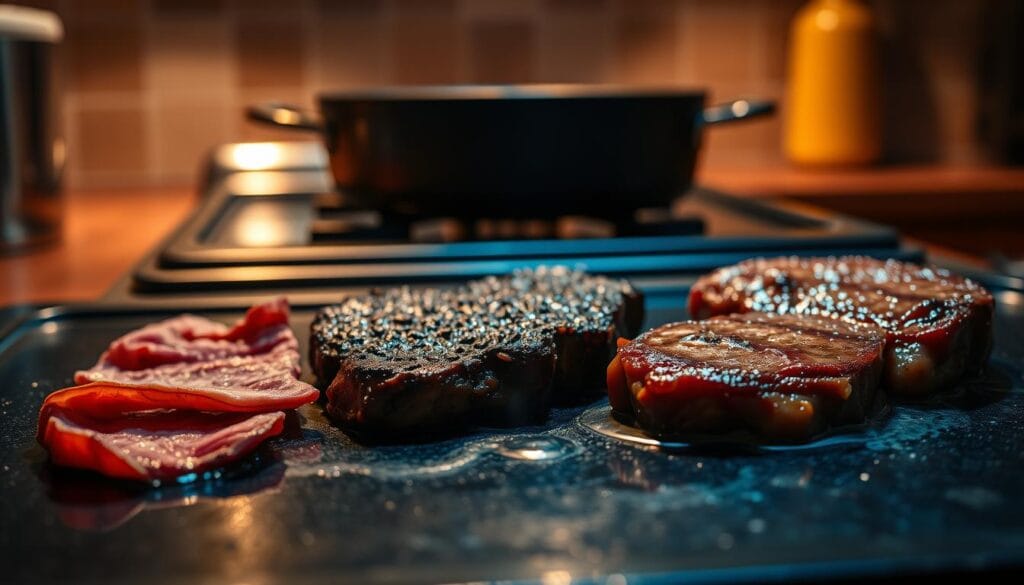
Making the perfect homemade steak recipe can be challenging, even for seasoned cooks. To achieve a great easy steak dinner, it’s important to know and avoid common mistakes. These mistakes can ruin your carefully chosen cut of meat.
When cooking your pan-seared steak, be careful of these major errors:
- Using a cold pan: Always preheat your skillet to ensure a perfect sear
- Overcrowding the pan: Leave enough space between steaks for proper heat circulation
- Moving the steak too much: Let the meat develop a beautiful crust before flipping
- Skipping the resting period: Allow your steak to rest after cooking to retain juices
Temperature control is key for your easy steak dinner. Many home cooks forget to use a meat thermometer. This leads to overcooked or undercooked meat. A good thermometer ensures your steak is cooked just right every time.
Choosing the right pan is also crucial. A heavy-bottomed cast-iron skillet is best for heat distribution and crust formation. Stay away from non-stick pans, as they can’t reach the high temperatures needed for a perfect sear.
Pro tip: Pat your steak dry before cooking to ensure a crisp, golden-brown exterior.
Resting and Serving Your Pan-Seared Steak
Learning to rest your steak in skillet is as important as cooking it. After you’ve made your pan-seared steak, the last steps are key to success.
Resting lets the steak’s juices spread out evenly. This makes each bite tender and full of flavor. Without resting, your steak might end up dry and less tasty.
Understanding Proper Resting Times
The resting time depends on how thick your steak is:
- Thin cuts (½ inch): 5-7 minutes
- Medium cuts (1 inch): 7-10 minutes
- Thick cuts (1½ inches): 10-15 minutes
Creative Plating Techniques
Make your Pan-Seared Steak in Butter Sauce look like it’s from a fancy restaurant with these tips:
- Use a warm plate to keep the steak hot
- Slice against the grain for tenderness
- Drizzle the leftover butter sauce over the steak
- Add fresh herbs like thyme or rosemary for garnish
Your steak, perfectly rested and beautifully presented, will wow anyone who tries it.
Complementary Side Dishes for Your Steak
Creating a great steak dinner is more than just a good steak. The right sides can make your meal amazing. Think about flavors, textures, and cooking times when picking sides.
When planning your steak, consider these classic side dish categories:
- Potato-Based Sides
- Roasted garlic mashed potatoes
- Crispy smashed herb potatoes
- Truffle parmesan fries
- Vegetable Options
- Grilled asparagus with lemon zest
- Roasted Brussels sprouts
- Sautéed mushrooms with thyme
- Unique Accompaniments
- Creamy mushroom risotto
- Parmesan polenta
- Grilled corn with chili butter
Timing is key for a great steak dinner. Start with sides that take longer to cook. Potatoes and roasted veggies can cook while your steak rests. This way, everything is hot and perfect when you serve it.
| Side Dish | Prep Time | Cooking Time |
|---|---|---|
| Roasted Garlic Mashed Potatoes | 15 minutes | 30 minutes |
| Grilled Asparagus | 5 minutes | 8-10 minutes |
| Mushroom Risotto | 10 minutes | 25 minutes |
Pro tip: Pick sides that go well with your steak’s rich sauce. Light, fresh veggies or starchy sides with herbs can balance the meal. They make the whole experience better.
Wine Pairing Suggestions for Your Steak Dinner
Finding the perfect wine can make your steak dinner unforgettable. The right wine brings out the best in your buttery steak sauce. It makes every bite even more enjoyable.
Red wines are the top choice for steak. They match the bold flavors of the meat and sauce perfectly.
- Cabernet Sauvignon: A classic choice with full-bodied profile
- Malbec: Offers bold fruit notes that cut through the steak’s richness
- Syrah/Shiraz: Provides spicy undertones that match the buttery steak sauce
The type of wine you choose depends on your steak’s cut and how it’s prepared. Leaner steaks go well with lighter red wines. Fattier steaks need stronger wines.
| Steak Cut | Recommended Wine | Flavor Profile |
|---|---|---|
| Ribeye | Cabernet Sauvignon | Intense, full-bodied |
| Filet Mignon | Pinot Noir | Lighter, elegant |
| New York Strip | Malbec | Bold, fruity |
Don’t be afraid to try new wine pairings. Sometimes, a different wine can take your steak dinner to a whole new level.
Conclusion
Your journey to perfect pan-seared steak is now complete. You’ve learned the art of seared steak, turning simple meals into special moments. Quality ingredients, precise techniques, and creativity are the secrets to success in your kitchen.
Practicing your steak recipe is key. Each time, you’ll get better, learning how different cuts react to heat and how butter can enhance flavors. Pan-searing is more than following steps; it’s about gaining confidence and intuition in cooking.
Don’t be afraid to try new cuts of beef, mix different seasonings, and work on your butter sauce. With patience and practice, you’ll make steaks that rival those of chefs. Your culinary journey has just started, and the kitchen is your place for tasty discoveries.
Whether it’s a weeknight dinner or a special event, your new skills will make the meal unforgettable. Trust your abilities, your ingredients, and most importantly, enjoy the delicious outcome of your hard work.

